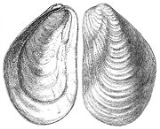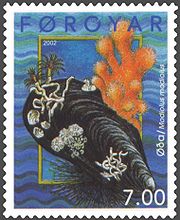
Modiolus modiolus
Encyclopedia
Modiolus modiolus, common name northern horsemussel, is a species
of marine
bivalve
mollusk in the family Mytilidae
.

are roughly triangular or bluntly oblong with rounded umbones near the anterior end. The annual growth lines are clear and there is a fine sculpturing of concentric grooves and ridges. The interior of the shell is white with a broad pallial line, large anterior adductor muscle scar and smaller posterior adductor muscle scar. The body is deep orange and the mantle is unfrilled. The shell is firmly attached to the substrate by byssus
threads.
to Florida
, and along the Pacific coast, from the Arctic Ocean to California
. It is also found on the European seaboard of the Atlantic Ocean from the United Kingdom northwards. It is found from low tide mark to depths of 50 metres in British waters and 80 metres off the coast of Nova Scotia
.
upon by starfish such as Asterias vulgaris, the whelk Buccinum undatum
and crabs. Juveniles growing on byssus threads are more likely to survive than free living individuals and this results in the formation of cold-water reefs of mussels. These mostly occur in locations with fairly strong currents. The species is tolerant of low levels of oxygen and of a diminished quantity of the phytoplankton
on which they feed. The boring sponge Cliona celata
sometimes damages the shells of older individuals.
Species
In biology, a species is one of the basic units of biological classification and a taxonomic rank. A species is often defined as a group of organisms capable of interbreeding and producing fertile offspring. While in many cases this definition is adequate, more precise or differing measures are...
of marine
Marine (ocean)
Marine is an umbrella term. As an adjective it is usually applicable to things relating to the sea or ocean, such as marine biology, marine ecology and marine geology...
bivalve
Bivalvia
Bivalvia is a taxonomic class of marine and freshwater molluscs. This class includes clams, oysters, mussels, scallops, and many other families of molluscs that have two hinged shells...
mollusk in the family Mytilidae
Mytilidae
Mytilidae is a family of small to large saltwater mussels, marine bivalve mollusks in the order Mytiloida. It is the only family in the order...
.

Description
Modiolus modiolus is a large mussel growing to 22cm (9ins) long though 10cm (4ins) is a more typical size. The shell is purpleish or dark blue and robust, with horny protuberances when young. The two valvesBivalve shell
A bivalve shell is part of the body, the exoskeleton or shell, of a bivalve mollusk. In life, the shell of this class of mollusks is composed of two parts, two valves which are hinged together...
are roughly triangular or bluntly oblong with rounded umbones near the anterior end. The annual growth lines are clear and there is a fine sculpturing of concentric grooves and ridges. The interior of the shell is white with a broad pallial line, large anterior adductor muscle scar and smaller posterior adductor muscle scar. The body is deep orange and the mantle is unfrilled. The shell is firmly attached to the substrate by byssus
Byssus
Byssus means both a silky filament by which certain molluscs attach themselves to hard surfaces, and a rare fabric, also called sea silk and its fibre source.-Word:...
threads.
Distribution
M. modiolus can be found along the Atlantic coast of North America, from the Arctic OceanArctic Ocean
The Arctic Ocean, located in the Northern Hemisphere and mostly in the Arctic north polar region, is the smallest and shallowest of the world's five major oceanic divisions...
to Florida
Florida
Florida is a state in the southeastern United States, located on the nation's Atlantic and Gulf coasts. It is bordered to the west by the Gulf of Mexico, to the north by Alabama and Georgia and to the east by the Atlantic Ocean. With a population of 18,801,310 as measured by the 2010 census, it...
, and along the Pacific coast, from the Arctic Ocean to California
California
California is a state located on the West Coast of the United States. It is by far the most populous U.S. state, and the third-largest by land area...
. It is also found on the European seaboard of the Atlantic Ocean from the United Kingdom northwards. It is found from low tide mark to depths of 50 metres in British waters and 80 metres off the coast of Nova Scotia
Nova Scotia
Nova Scotia is one of Canada's three Maritime provinces and is the most populous province in Atlantic Canada. The name of the province is Latin for "New Scotland," but "Nova Scotia" is the recognized, English-language name of the province. The provincial capital is Halifax. Nova Scotia is the...
.
Ecology
M. modiolus is found growing on hard substrates including shells and stones and the byssus threads of other mussels. Survival rates of young individuals are low but by the time they reach about 4cm long, at an age of 4 years, individuals are too large and tough to be predatedPredation
In ecology, predation describes a biological interaction where a predator feeds on its prey . Predators may or may not kill their prey prior to feeding on them, but the act of predation always results in the death of its prey and the eventual absorption of the prey's tissue through consumption...
upon by starfish such as Asterias vulgaris, the whelk Buccinum undatum
Buccinum undatum
Buccinum undatum, known as the common whelk, is a large edible marine gastropod in the family Buccinidae, the "true whelks".-Distribution:...
and crabs. Juveniles growing on byssus threads are more likely to survive than free living individuals and this results in the formation of cold-water reefs of mussels. These mostly occur in locations with fairly strong currents. The species is tolerant of low levels of oxygen and of a diminished quantity of the phytoplankton
Phytoplankton
Phytoplankton are the autotrophic component of the plankton community. The name comes from the Greek words φυτόν , meaning "plant", and πλαγκτός , meaning "wanderer" or "drifter". Most phytoplankton are too small to be individually seen with the unaided eye...
on which they feed. The boring sponge Cliona celata
Cliona celata
Cliona celata, occasionally called the Red Boring Sponge, is a species of demosponge belonging the family Clionaidae. It is found worldwide. This sponge creates round holes up to 5 cm in diameter in limestone or the shells of molluscs, especially oysters...
sometimes damages the shells of older individuals.

